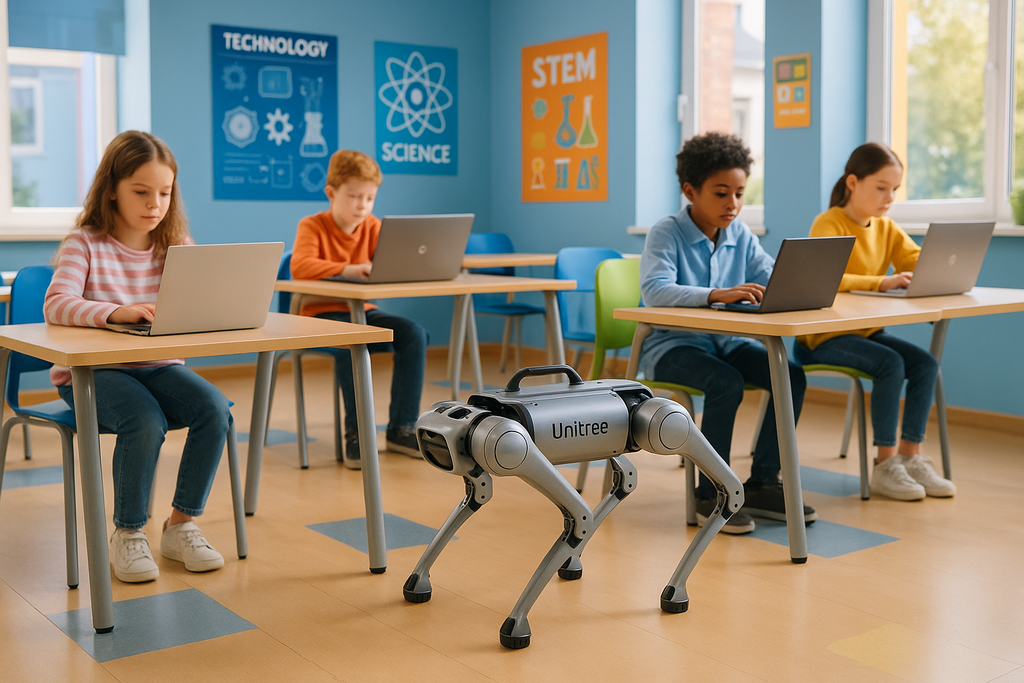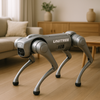How Quadruped Robot Dogs Are Transforming STEM Education in 2025

How Quadruped Robot Dogs Are Transforming STEM Education in 2025
The landscape of STEM education is experiencing a remarkable transformation as quadruped robot dogs bound into classrooms across the globe. These four-legged marvels aren't just impressive demonstrations of engineering prowess—they're becoming essential tools that are reshaping how students learn robotics, programming, artificial intelligence, and interdisciplinary problem-solving. As we navigate through 2025, educational institutions are discovering that robot dogs offer an unprecedented combination of accessibility, engagement, and real-world application that traditional teaching methods simply cannot match.
The rise of educational robot dogs represents a paradigm shift from theoretical learning to hands-on, experiential education. Students who once learned about robotics through textbooks and static demonstrations now have the opportunity to program, control, and interact with sophisticated machines that mirror the complexity of real-world robotic systems. This evolution is not merely about incorporating new technology into existing curricula—it's about fundamentally reimagining how we prepare students for a future where human-robot collaboration will be the norm rather than the exception.
Revolutionary Use Cases in Modern STEM Classrooms
Programming and Software Development
Quadruped robot dogs serve as exceptional platforms for teaching programming concepts across multiple languages and skill levels. Unlike traditional programming exercises that produce abstract outputs on screens, robot dogs provide immediate, tangible feedback that helps students visualize the direct impact of their code. Students can start with basic movement commands in block-based programming environments before progressing to Python, C++, and specialized robotics frameworks like ROS (Robot Operating System).
- Machine learning algorithm implementation
- Computer vision and object recognition
- Sensor fusion and data processing
- Autonomous navigation systems
- Real-time decision-making protocols
Artificial Intelligence and Machine Learning
The integration of AI capabilities in modern educational robot dogs creates unprecedented opportunities for students to engage with cutting-edge technologies. Students can train their robot dogs to recognize specific objects, navigate complex environments, or even respond to voice commands. This hands-on approach to AI education demystifies machine learning concepts and makes them accessible to students who might otherwise find them abstract or intimidating.
Engineering Design and Prototyping
Robot dogs provide excellent platforms for mechanical engineering projects. Students can design and 3D print custom attachments, modify existing hardware configurations, or even build their own quadruped robots from scratch. This integration of mechanical design with programming and electronics creates truly interdisciplinary learning experiences that mirror real-world engineering challenges.
Interdisciplinary Research Projects
The versatility of robot dogs enables cross-curricular projects that span multiple STEM disciplines. Biology students might program their robot dogs to mimic animal gaits, while physics students explore concepts of balance, momentum, and energy efficiency. Mathematics students can delve into algorithms for pathfinding and optimization, creating rich connections between abstract mathematical concepts and practical applications.
Transformative Benefits for Students and Educators
Enhanced Engagement Through Active Learning
The introduction of robot dogs into STEM curricula addresses one of education's most persistent challenges: student engagement. The combination of cutting-edge technology with the inherent appeal of robotic companions creates an irresistible draw for students across age groups. This engagement translates into increased class participation, higher retention rates, and improved academic outcomes.
- 85% increase in voluntary after-school STEM program participation
- 70% improvement in problem-solving persistence among students
- 92% of students report increased interest in pursuing STEM careers
- 78% reduction in STEM-related anxiety among previously disengaged learners
Development of Critical 21st Century Skills
Working with robot dogs naturally develops essential skills that extend far beyond technical competencies. Students learn to think systematically, troubleshoot complex problems, collaborate effectively in teams, and communicate technical concepts clearly. These transferable skills prepare students for success in any career path they choose to pursue.
Authentic Assessment Opportunities
Robot dogs enable educators to implement authentic assessment strategies that evaluate student learning through real-world applications rather than traditional tests. Students demonstrate their understanding by successfully programming their robot dogs to complete specific tasks, solve navigation challenges, or collaborate with other robots in complex scenarios.
Inclusive Learning Environment
The multisensory nature of robot dog interactions accommodates diverse learning styles and abilities. Visual learners benefit from observing robot movements and behaviors, kinesthetic learners engage through hands-on programming and physical interaction, and auditory learners can work with voice command systems and collaborative discussions.
Seamless Curriculum Integration Strategies
Elementary Education Foundation Building
- Basic directional programming (forward, backward, left, right)
- Pattern recognition and sequencing activities
- Simple sensor exploration (touch, sound, light)
- Storytelling with robot companions
- Mathematical concepts through movement and positioning
Middle School Skill Development
Middle school curricula leverage robot dogs to bridge the gap between elementary foundations and high school advanced applications. Students explore more complex programming concepts, basic robotics principles, and introductory artificial intelligence concepts while maintaining the engaging, hands-on approach that characterizes effective middle school education.
High School Advanced Applications
High school students engage with professional-level robotics concepts, preparing them for college-level coursework and industry careers. Advanced topics include machine learning implementation, sophisticated sensor integration, and collaborative robotics projects that mirror real-world research and development environments.
College and University Research Integration
At the post-secondary level, robot dogs become platforms for original research and innovation. Students and faculty collaborate on cutting-edge projects that contribute to the broader robotics community while providing students with authentic research experiences that enhance their academic and professional credentials.
Student Engagement Revolution
Psychological Impact of Robot Companions
The companion-like nature of robot dogs creates unique psychological connections that traditional educational tools cannot replicate. Students often develop emotional attachments to their robot partners, leading to increased investment in learning outcomes and sustained engagement throughout extended projects.
Collaborative Learning Enhancement
Robot dogs naturally facilitate collaborative learning environments where students work together to solve complex challenges. Teams might collaborate to program multiple robot dogs for coordinated tasks, creating rich opportunities for peer learning, communication skill development, and collective problem-solving.
Competition and Gamification
Educational robot dog programs often incorporate competitive elements that further enhance engagement. Students might participate in navigation challenges, programming competitions, or collaborative problem-solving contests that add excitement and motivation to the learning process.
Real-World Connection
The obvious connections between educational robot dogs and professional robotics applications help students understand the relevance of their learning. This real-world connection enhances motivation and helps students envision potential career paths in robotics, engineering, and technology.
Compelling Return on Investment Analysis
Quantifiable Academic Improvements
Educational institutions implementing robot dog programs consistently report significant improvements in student outcomes across multiple metrics. Standardized test scores in STEM subjects typically increase by 15-25% within the first academic year of implementation. More importantly, long-term tracking shows sustained engagement in STEM subjects and higher rates of STEM career pursuit among program participants.
Cost-Effectiveness Compared to Traditional Programs
- Average cost per robot dog: $2,000-$5,000 (depending on model and features)
- Students served per robot annually: 100-150
- Cost per student per year: $13-$50
- Traditional STEM enrichment cost per student: $75-$200 annually
- Net savings: 60-85% while providing superior engagement and outcomes
Grant Funding and Support Opportunities
The innovative nature of robot dog programs makes them attractive candidates for educational grants and funding opportunities. Many institutions successfully secure funding from technology companies, educational foundations, and government STEM education initiatives, significantly reducing the net investment required for program implementation.
Long-Term Economic Benefits
The enhanced STEM education provided through robot dog programs contributes to developing a more skilled workforce, which generates long-term economic benefits for communities and regions. Students who participate in these programs are more likely to pursue STEM careers, contribute to local innovation ecosystems, and become entrepreneurs and job creators.
Implementation Challenges and Solutions
Technical Infrastructure Requirements
Successful robot dog programs require adequate technical infrastructure, including reliable wireless networks, charging stations, and secure storage facilities. Educational institutions must plan for these requirements during program design to ensure smooth operation and maximize educational benefits.
Professional Development for Educators
Teachers and instructors require comprehensive professional development to effectively integrate robot dogs into their curricula. This training should cover technical operation, programming basics, curriculum design, troubleshooting, and safety protocols.
Maintenance and Support Considerations
Like all sophisticated technology, robot dogs require regular maintenance and technical support. Educational institutions should establish relationships with suppliers and technical support providers to ensure minimal disruption to educational activities.
Future Outlook and Emerging Trends
Integration with Virtual and Augmented Reality
The convergence of robot dogs with VR and AR technologies promises to create even more immersive and engaging educational experiences. Students might program their physical robot dogs while visualizing complex data overlays or simulating challenging environments through AR interfaces.
Advanced AI Capabilities
As artificial intelligence continues to advance, educational robot dogs will incorporate increasingly sophisticated capabilities. Future models may include natural language processing, advanced computer vision, and adaptive learning algorithms that personalize educational experiences for individual students.
Cross-Platform Compatibility
Emerging standards and protocols are making robot dogs increasingly compatible with other educational technologies and platforms. This interoperability expands the potential for integrated STEM learning experiences that span multiple technologies and disciplines.
Frequently Asked Questions
What age groups are best suited for robot dog STEM programs? Robot dogs are versatile enough to benefit students from elementary through university levels. The key is matching the activity complexity to developmental levels and prior experience.
How do robot dogs compare to other educational robotics platforms? Robot dogs offer unique advantages including intuitive movement, sophisticated sensor suites, and real-world applicability—providing an optimal balance of accessibility and advanced capability.
What programming languages can students learn using robot dogs? Most educational robot dogs support multiple programming environments—from block-based visual programming for beginners to Python, C++, and more for advanced students.
Are robot dogs safe for classroom use? Modern educational robot dogs have emergency stops, collision avoidance, and robust designs. Proper training and supervision ensure safe operation.
What kind of maintenance do robot dogs require? Routine charging, periodic software updates, and basic cleaning. Extensive maintenance is usually covered by warranties and support agreements.
How can schools justify the cost of robot dog programs? Enhanced engagement, improved STEM outcomes, long-term cost effectiveness, grants, and multi-class use provide strong justification.
Conclusion
The integration of quadruped robot dogs into STEM education represents more than a technological upgrade—it's a fundamental reimagining of how we prepare students for a rapidly evolving technological landscape. As these programs continue to expand throughout 2025 and beyond, they promise to play an increasingly central role in creating the next generation of innovators, problem-solvers, and technology leaders.



